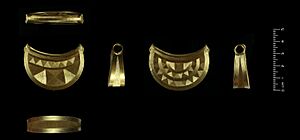Shropshire bulla facts for kids
Quick facts for kids Shropshire bulla |
|
|---|---|

Shropshire bulla, different views
|
|
| Material | Gold, silver, copper |
| Size | Height: 36 mm, width: 47.4mm |
| Created | 1000 BC – 750 BC |
| Period/culture | Late Bronze Age |
| Discovered | May 12, 2018 Shropshire, England |
| Present location | British Museum |
The Shropshire bulla is a special gold pendant from the Late Bronze Age. It was found in 2018 in Shropshire, England, by someone using a metal detector. A 'bulla' (say: BULL-uh) is a kind of charm or pendant.
This golden bulla is very important because it's only the eighth one ever found in Britain and Ireland. It's also just the second one found in England! This amazing pendant has cool, detailed patterns carved into it. Today, you can see it at the British Museum in London.
Experts say the Shropshire bulla shows incredible skill. The way it was made and decorated is almost unmatched for its time in Britain.
The exact spot where it was found is a secret. It's only known as the "Shropshire Marches". This means it was found on the western side of Shropshire, near the border with Wales.
Contents
What is the Shropshire Bulla?
The Shropshire bulla is a hollow object shaped like a letter 'D'. It was made from pieces of gold metal by a very talented craftsperson. Bullae were probably worn as charms or pendants, much like jewelry today.
This bulla is special because it's "reversible". Both the front and back have the same design. This means it looks great no matter which way you wear it! Bullae were likely very valuable. People wore them to show off their high status and wealth.
How Was It Made?
The pendant has a detailed pattern carved into it. This pattern includes tiny triangles with neat, diagonal lines. Scientists have looked closely at the bulla. They found it's mostly gold (about 79-81%). It also has some silver (14-16%) and a little bit of copper.
The bulla is about 47.4 mm (1.87 in) wide and 36.7 mm (1.44 in) tall. It weighs 26.6 g (0.94 oz).
History of the Discovery
In May 2018, a metal detectorist called Peter Reavill, who helps find ancient objects in Shropshire, got a call. The detectorist had found something amazing! To keep the discovery spot safe, the names of the finder and landowner were not shared.
When Peter Reavill saw photos of the gold pendant, he first thought it might be a missing bulla. That bulla was found in 1772 but disappeared after being sold in 1806. However, after more study, he realized this new find was different.
Why is it so Important?
The Shropshire bulla is only the second one ever found in England. It's also the eighth found in all of Britain and Ireland. This discovery is very important because it shows that people in this part of Britain during the Late Bronze Age were skilled at working with gold. It also suggests there might have been rich gold deposits in the area.
The British Museum has called it "one of the most significant pieces of Bronze Age gold metalwork" ever found in Britain. It is now at the British Museum. There, experts are studying it to learn even more about this incredible ancient treasure.

